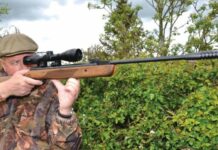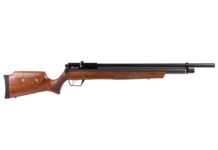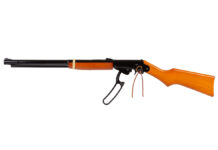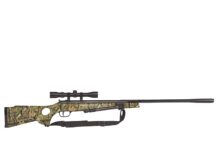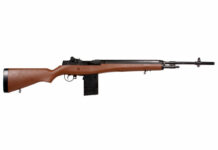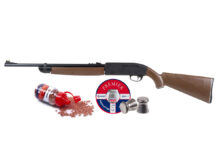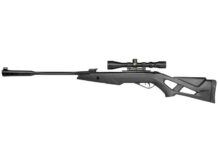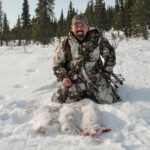
Not all crossbows shoot dead-center right out of the box. Here’s a look at how to get the most consistent crossbow accuracy out of your gear.
After 25 years of hunting with, reviewing and shooting crossbows for the outdoor industry, I have come to one irrefutable conclusion: Not all crossbows are the tack-driving one-holers most hunters think they are — at least not initially.
To be fair, the majority of crossbows, even those that require the purchaser to mount their own scope, will cluster arrows in a 6-inch circle at 10 yards, but this is far from the holy grail of accuracy.
Achieving pinpoint accuracy with a crossbow begins with proper assembly of the crossbow, ensuring that all stock and scope screws, bolts and fittings are aligned and tight. When it comes to accuracy, even the minutia matters, like lubing the rail between shots per the manufacturer’s recommendations.
Table of Contents
ARROWS
Believe it or not, an assortment of arrows can be found in some horizontal hunters’ quivers. It is essential that all arrows be of the same length and weight (and brand and model). Variations here can cause headaches when trying to get consistent arrow flight.
By all means, take the time to make certain all your arrows match prior to shooting them.
As anyone who has shopped for a new broadhead has discovered, there is a dizzying number available. Generally speaking, the shorter, tighter and more aerodynamic the design, the better the accuracy.
For most crossbow applications, mechanical-style broadheads perform best, as they wind-plane less than exposed-blade models (i.e., “fixed blades”). At 20 yards the differences are difficult to discern; however, as target distances increase, the errant broadhead’s flight miscue is multiplied.
ADJUSTABILITY
Many crossbows have adjustable stocks and foregrips. This allows the user to customize the length of pull. To achieve maximum efficiency, the shooter must hold and aim his crossbow the same way every time, without variation.
Because of these varying elements, it makes sense that a hunter should spend a considerable amount of time at the range to get the maximum accuracy out of his crossbow at 20, 30 and 40 yards.
While the majority of crossbows are suitably accurate for wild game at these distances, there are some variations that shooters must be aware of and be prepared to compensate for.
SCOPED
Most modern crossbow scopes are designed and made for crossbow shooting using crosshairs, circles or dots to indicate distances out to 60 yards (sometimes further).
Generally, all such scopes are accurate as designed out to 40 yards, after which accuracy tends to decline. The only way to find out is to sit down at a bench and shoot three or four arrows at each distance from a steady rest.
The basic standard is to sight in for 20 yards with the top-most scope reticle and then increase the distance in 10-yard increments.
For most crossbows, reliable accuracy under hunting conditions is assured out to 40 yards, but beyond that crossbow accuracy begins to fall off for a number of reasons, including wind deflection, loss of arrow speed and shooter error.
For all intents and purposes, hunters are advised to limit their shots at game to 45 yards (60 yards out West but only under perfect, windless, obstacle-free conditions). Target shooters may double those standards for competitions, although accuracy will inevitably fizzle as the distance to the target increases.

CROSSBOW FORM
Because crossbows are built in a horizontal fashion, it is important that shooters address every aspect of the shot, including proper stance, foregrip, trigger pull and follow-through.
There are few better qualified to discuss the nuances of accurate crossbow shooting than Mark Beck, an International Bowhunter’s Organization (IBO) World Crossbow Champion.
Beck, who makes his living designing crossbows for Carbon Express, offered some surprisingly simple tips for crossbow shooters who want to improve their accuracy.
“Basically, crossbow shooters should use the same disciplines taught in firearms training,” Beck said, “but remember that the trajectory of an arrow is 1/10 that of the average firearm.
“Choose arrows that are within plus or minus 1 grain of each other,” Beck added, noting that hunters and target shooters should use field points or broadheads that are within 1 grain of each other.
Beck says there are four points to consistently accurate crossbow shooting.
First, he said, find the “balance point of the crossbow” and maintain a steady, consistent grip during each shot.
Beck says that shooters should strive to achieve the same field of view through the crossbow scope every time, because a skewed field of view has a tremendous effect on accuracy. Be sure the field of view is clear, sharp, centered, Beck advised.
Beck also stressed that shooters must seek a consistent cheek weld (where the cheek rests on the stock). The slightest variation will change the arrow’s point of impact.
“Some competition shooters mark the stock with tape to ensure that their cheek hits the same point each time,” Beck said. “The more consistent you are with your shooting position the more accurate you are going to be.”
Regarding triggers, Beck was adamant that shooters avoid tinkering with factory triggers to adjust pull weight or creep. Doing so, he said, could result in trigger failure, injury to the shooter, or damage to the crossbow and would void the manufacturer’s warranty.

When it comes to trigger pull, Beck counsels, “Any crossbow can be fired accurately by using the first knuckle behind the fingernail as an anchor point. The second knuckle then becomes the pivot point. Practice your trigger pull using a slow, steady pull with the trigger held firmly behind that first knuckle.”
Finally, Beck recommended that bench shooters who intend to hunt deer, turkeys or other game spend time at a 3D range to get used to field shooting conditions and situations.
TREESTAND SHOOTING
Generally speaking, there is no need for elevation compensation when shooting 20 or 30 yards from tree stands that are 15 to 20 feet off the ground.
However, when elevations are much steeper (when hunting out of a tree stand that is 25 or more feet off the ground, or when the target is extremely close to the stand) it may be necessary to aim low in order to compensate for the arcing arrow.
It is recommended that tree stand crossbow hunters practice shooting at silhouette targets set at varying distances from the stand.
This includes shots near the tree base and out to 40 yards, especially when the elevations are such that ballistic compensation is required.
Whenever possible, practice shooting from the same stand you intend to hunt out of, whether fixed-position, ladder or a climbing tree stand. Have a partner place a foam target in various positions at random distances from the stand to simulate real-time hunting situations.
Use your range finder and your good judgment in deciding when to shoot or when to wait for a better opportunity.
GROUND BLIND SHOOTING
Shots from ground blinds are usually straightforward — assuming there are no obstacles or obstructions that might interfere with the crossbow or the arrow in flight.
More than one crossbow hunter has shot the ground blind instead of the trophy standing 20 yards in front of them. When preparing for the shot, make certain the arrow will clear the blind prior to attempting the shot.
Also, ensure that there are adequate, brush-free shooting lanes to avoid arrow contact with twigs, leaves and other debris. When cutting shooting lanes, consider the arrow’s arcing flight path, and cut paths high enough to allow the arrow to fly without impediments.
FREE-FORM SHOOTING
Stalking and still-hunting with a crossbow are challenging simply because crossbows are wide, heavy and awkward to carry over long distances. Always use a sling because carrying a crossbow at the ready while still-hunting will prove to be a chore for even the most athletic of hunters.
In any case, when shooting at game offhand it is important the hunter assume a solid stance with feet comfortably apart and shoulders back with the crossbow’s limbs level. Prop your bow hand into the ribs on the elbow and then use breathing techniques to steady the scope reticle.
COMMON MISTAKES
There are many common mistakes crossbow hunters make that can be easily addressed. The most common is failing to shoot your hunting arrows, those equipped with broadheads, prior to attempting to shoot them at an animal. If you don’t shoot your hunting arrows prior to using them in the field, don’t be surprised when you miss horribly.
Another common error affecting crossbow hunters is failure to use a range finder on every shot. An error in range estimation of just 5 yards can mean the difference between a hit or miss.
Upon arrival at your stand or blind, settle in and then spend some time ranging nearby landmarks. Determine where 20, 30 and 40 yards are by ranging individual trees, rocks or other prominent points. Some hunters use colored flagging or reflective tacks to mark yardages around their hunting site.
Many hunters use their crossbows only on weekends or holidays during the hunting season and then put them away until the following year. To remain familiar and effective with your crossbow, plan to shoot at least 20 arrows two or three times per week year ‘round. Shoot again any time the crossbow is transported, dropped, bumped or exposed to extreme temperatures.
Some crossbow hunters fail to maintain their crossbows per the manufacturer’s instructions. Over time crossbow cables and strings stretch or fray, limbs weaken and parts gum up. Every manufacturer has its own unique maintenance policy — make certain you read it and follow their recommendations.
Lastly, should your crossbow ever require repair, seek a trained professional who is familiar with your specific crossbow and factory-certified. If one is not available locally, by all means send your crossbow back to the manufacturer. Attempting to make your own crossbow repairs is never advised and can be dangerous.




